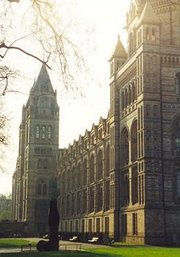Natural History Museum
|
|

The Natural History Museum, one of three large museums located on Exhibition Road, Kensington, London, England (the others are the Science Museum and the Victoria and Albert Museum), is home to life and earth science collections comprising some 70 million specimens or items. There are five main collections: Botany, Entomology, Mineralogy, Palaeontology and Zoology.
The museum is renowned for its Central Hall and its exhibition of dinosaur skeletons, particularly the large Diplodocus cast which dominates the entrance.
The foundation of the collection was a bequest by English doctor Sir Hans Sloane (1660-1753). Sloane's collection, which included dried plants, and animal and human skeletons, was initially housed in Montague House in Bloomsbury in 1756, and was considered part of the British Museum. In the late 1850s, Professor Richard Owen, Superintendent of the natural history departments of the British Museum, became convinced that the natural history departments needed a bigger, separate building.
Land in South Kensington was purchased, and in 1864 a competition was held to design the new museum. The winning entry was submitted by Captain Francis Fowke who died shortly afterwards. The scheme was taken over by Alfred Waterhouse who substantially revised the agreed plans, and designed the facades in his own idiosyncratic Romanesque style. Work began in 1873 and was completed in 1880. The new museum opened in 1881, although the move from the old museum was not fully completed until 1883.
Both the interiors and exteriors make extensive use of terracotta bricks to resist the sooty climate of Victorian London. The terracotta for the interior and exterior was made by the famous Gibbs And Canning Limited of Tamworth. The bricks include many images of plants, animals and fossils. The central axis of the museum is aligned with the tower of Imperial College (formerly the Imperial Institute) and the Royal Albert Hall and Albert Memorial further north. These all form part of the complex known as Albertopolis.
Legally, it remained a department of the British Museum, and its formal name was the British Museum (Natural History), often abbreviated in the scientific literature as B.M.(N.H.). In 1963, the Natural History Museum finally became an independent museum with its own Board of Trustees, and in 1986 absorbed the adjacent Geological Museum of the British Geological Survey. However it was not until the Museums and Galleries Act of 1992 that the Museum's formal title was finally changed from B.M.(N.H.) to The Natural History Museum
Nhm-lond-earthg.jpg
In the 1990s the Geological Museum's mineralogy displays, previously described as "just a collection of rocks in cabinets", were completely rebuilt and relaunched in 1998 as a multimedia exhibition entitled The Earth Galleries. At the same time, the other departments in the Waterhouse building were retitled The Life Galleries. The Natural History Museum's own Mineralogy displays remain unchanged as an example of the nineteenth century display techniques of the Waterhouse building.
The newly-developed Darwin Centre (named for Charles Darwin) holds a collection of millions of preserved specimens, interactive materials and new workspaces for the Museum's scientific staff. Lectures and demonstrations occur daily, and are sometimes webcast. The shared space is designed to bring visitors into close contact with working scientists. Phase one of the Darwin Centre has been completed, and houses the Zoological department's spirit collections - organisms preserved in alcohol. Phase two of the project will bring the Entomology collections and Botanical collections under the same (new) roof. As of 2005, the Entomology Department is 'decanting' its collection before the building is to be pulled down and replaced.
The closest London Underground station is South Kensington.
External link
- Official website (http://www.nhm.ac.uk/)
- Kids website (http://www.nhm.ac.uk/kids-only/)
- Darwin Centre webcast page (http://www.nhm.ac.uk/nature-online/science-of-natural-history/darwin-centre-live/index.html)
- Research and Curation site (http://www.nhm.ac.uk/research-curation/)
- Search all online collections and research data (http://internt.nhm.ac.uk/jdsml/mils/index.dsml?istopmenu=true&topcat=research&action=textsearch)
- Website of the daughter Museum at Tring, Hertfordshire (http://www.nhm.ac.uk/tring/)
de:Natural History Museum es:Museo de historia natural de Londres

